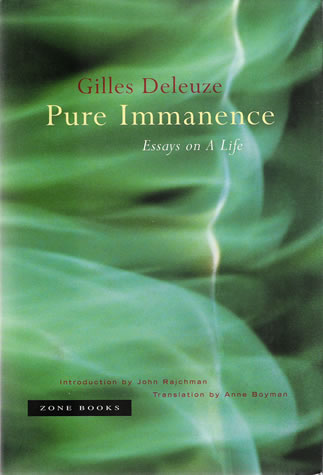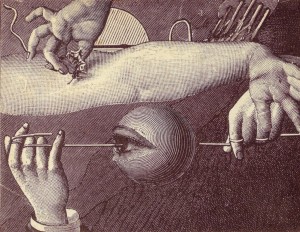Nietzsche’s Genealogy of Morals investigates the reasons why we have historically insisted upon the good-vs.-evil pairing as the determining principle of moral action, when, inherent in that pairing is a certain wrinkle, a glitch, introduced by the incongruous fact of the bad. What is bad to Nietzsche? Perhaps it is the blow from nowhere; the shock of pain that only registers as hostile once the overwhelming presence of feeling wears off enough for the victim to judge it. It is bad yet Nietzsche welcomes it. If, as Professor Buck-Morss has suggested, we are to re-think the universal/particular formula as, instead, the universal/singular, the oppositional relation would become less clear, less self-evident—the two terms begin to look a lot like each other. Similarly, if we were to turn our attention away from good-and-evil and toward something else instead, would we find ourselves in a world less easily distilled into a system of interdependently significant and thus utterly comprehensible opposites? That comprehensibility is the key to what Nietzsche contests in our moral behavior. Something about our love of good and distaste for evil implies a retreat from the real conditions which might provoke such evaluation in the first place. It is our emphasis upon comprehensibility as the most sought-after quality of reality that, for him, weakens us. Thinking isolated from experience and enthroned as life’s transcendent principle is the threat, the insult, to which we are enslaved. When it is the good/evil pairing that directs the manner in which one approaches or avoids things in life, it is in fact that mediation, that dependence upon the director, that threatens us—not evil. The evaluative faculty itself is our highest good and then, what would our evil be—the body? Is Nietzsche’s project in Genealogy of Morals, then, to eliminate the “good” and thus find a new mate for the “bad”? And, in doing this, would he consequently put an end to the ease and quickness with which we recognize one thing as another thing’s opposite?
Deleuze gives us insight into how that might happen in his discussion of Nietzsche’s famous frail-bodiedness. (and this is a quote from Pure Immanence): “(Nietzsche did not) think of illness as an event that affects a body-object or a brain-object from the outside. Rather, he saw in illness a point of view on health; and in health, a point of view on illness” (58). The difference between these two modes has to do with where the point of view originates. With illness construed as “an event that affects a body-object or a brain-object from the outside,” the affected body regards the fact of its pain in terms of that pain’s assumed cause. The illness has little to do with a lived and felt physical state and has everything to do with reason. My discomfort is to me nothing more than its reason, its cause, as once I feel it I have already evaluated and accepted that cause. Feeling begins in the quick move of my consciousness to step in and identify what I feel and why. And, in separating the pain I experience from who I am, I expel the body from the human in an effort that, for Nietzsche, belies my acquiescence to weakness, to fear, in this very attempt to protect myself. That I can remain a stable “I” despite undergoing attack by an outside enemy means that I’ve retreated from battle. Perhaps, under Deleuze’s formulation, evaluative intellect is itself a disease, attacking presence from an outside that only exists because the intellect says it does.
Then there is the other way to understand illness, which, according to Deleuze, served for Nietzsche as “a point of view on health; and in health, a point of view on illness.” Here, mind does not transcend matter but unfolds as a material activity. Illness, the feeling in the body, is itself a point of view, and that it is distinguished from health is only an expression of the fact of difference, which is the engine of experience. One feeling illuminates the next, so that what begins as the simple operation of difference can be called good or bad only as “an afterthought, an aside, a complementary color.” And the immediate intensity of feeling that accompanies both states serves to complicate any judgment that insists they are strictly opposed. The illness that faces health and the health that faces illness do not relate to each other simply in a mutually constitutive fashion—as, for example,the words “yes” and “no” whose meanings are annulled once either term is removed—but both terms are in fact each singular and very real—they are events—and it’s just that there’s no way of knowing what either one really is without removing oneself from the event. Perhaps there’s nothing to know, and it might do us good to stop wishing to know. To be satisfied in finding enough reason for illness in health and vice versa is the manner of living life that would constitute overall wellness in Nietzsche’s terms. It is a welcoming of the workings of difference whereas “happiness at the level of the powerless…(is) essentially a narcotic, an anaesthetic, rest, peace, sabbath, relaxation of the mind and stretching of the limbs” (21).
The complex relation that Deleuze illustrates via Nietzsche between healthy and unhealthy—the good and bad of the body—is exciting to me and hopeful because it emphasizes the existence of a reality that lies beyond the screen of logic and language. To Nietzsche, reality is only constructed if there is a will to construct it. He imagines a life that unfolds in reality rather than above it, trying to explain it. The mind he wishes we would claim for ourselves is something more interesting than a mere dissecting or bisecting tool, or a mechanism of dominance. It is in and with the body and as such does not absent itself from the present in order to find a strategic position from which to evaluate and thus subdue other minds. It is unconcerned with dominance and is instead interested in contest—a more generous, more respectful, even a loving relation to the would-be-dominated other.
Nietzsche writes: “actual love of enemies is also possible here and here alone—assuming it is possible at all on earth. How much respect a noble man has for his enemies!–and a respect of that sort is a bridge to love…For (the noble man) insists on having his enemy to himself, as a mark of distinction” (22). To appeal to the enemy rather than eliminate him. To recognize that there is a threat and to address that threat despite the risk it poses. Nietzsche’s call to invite contest into the practice of living is similar to Alain Badiou’s emphasis upon love. Both thinkers regard the perspective of the two—both my enemy and I, or both my lover and I, or both sickness and health, or both bad and good—as the optimal means for viewing reality. To incorporate into my nature the different nature of an other will would be to decline to live as just an “I” and to actively resist the stability of self-identity. Identity is a drive which neither Nietzsche nor Badiou imagine can or should be abolished but both posit that the acceptance of conflict—in the form of either battle or love—would activate a constant check upon one’s effort to settle into a stable—and thus dominating—selfhood.
Nietzsche’s critique isn’t aimed at power-as-such—for he accepts bloodlust as a healthy and undeniable expression of the animal in the human—but at our tendency to protect our potential for power by refusing to recognize and meet other wills-to-power. The I that truly wants dominance immerses itself in the work of asserting it. And here I am inclined to think about the surfing scene in Apocalypse Now, where the initial assault is staged from above, and the pretext for brutality is the anticipated pleasure in a spectacle sport, the aesthetic delight in that end rendering negligible any ugliness entailed by its means, so that the soldiers don’t experience the act of murder and can’t see how many they’ve killed. The surfer/soldier’s ardent wish to be both in the scene of battle and somewhere else indicates the kind of mind that wants health, that wants the good, that wants to win, without ever descending to taste the illness that threatens it. The good that positions itself above everything rather than in it, is perhaps the role we temporarily assume when we look at the world via the perspective offered by a movie camera. The wagnerian romance of Francis Ford Coppola’s battle scene grants to the cinema audience that same aesthetic thrill experienced by the pilot firing artillery from a helicopter on fleeing villagers who, from such an elevated vantage point, appear to move with the grace and order of a ballet troupe. To seek beauty in an aestheticized technological violence poses the following problem: if culture requires the spectacle of technological warfare for its own sustenance, what happens when the war is won? If the beautiful power of the one is not sufficiently justified in the subjugation of one other, as in Nietszche’s contest, or in Badiou’s “scene of the two”, but requires instead the annihilation of everything in its technologically expanded field of view, won’t the resources for this manner of aesthetic pleasure be quickly depleted? Where will we go to find our enemy? In other words, if total domination were possible, what would happen to difference? Where would our outside be?
Maybe it is the elevated perspective of the movie camera—its sweeping views that take in islands and oceans, skimming over sky and earth—that gives us a much-needed constant re-assurance that there is an outside, that there is another place from which we ourselves can be viewed. And the movie lets us temporarily occupy that place—in so doing, do we get to be Nietzsche’s poet spectators, divine witnesses, for whom the movements of war are orchestrated? The choreographed brutality that we saw in Copolla reminds me of Nietzsche’s festival for the gods. He writes: “All evil is justified if a god takes pleasure in it: so ran the primitive logic of feeling—and was this logic really restricted to primitive times? The gods viewed as the friends of cruel spectacles—how deeply this primeval concept still penetrates into our European civilization!” (44)
It seems to me that what Nietzsche primarily criticizes in his genealogy is our willingness to remain within a closed system. The mind that removes itself from battle or from love or from sickness becomes life’s own cause and outside. But what is the way out of this? I quote from the preface: “What if a regressive trait lurked in ‘the good man’, likewise a danger, an enticement, a poison, a narcotic, so that the present lived at the expense of the future? Perhaps in more comfort and less danger, but also in a smaller-minded, meaner manner? So that morality itself were to blame if man, as species, never reached his highest potential power and splendour?” (8) So, we can approach our rightful future if we allow will to lead us there rather than causal reasoning or morality, which anticipate and overtake every possible action before it is carried out. Nietzsche’s interest in allowing for the fulfillment of some potential power and freeing up the future seems to suggest that there is something waiting there, something further, that opens a sort of air vent in the present state of things. I’d like to end with the question: what is Nietzsche’s vision of this “highest potential and splendour”? What waits in our future that so desperately requires the dismantling our value systems? What ultimate value gives our potential its radiance and why, for Nietzsche,would the achievement of that potential be so overwhelmingly worth it?
—Miriam Atkin




